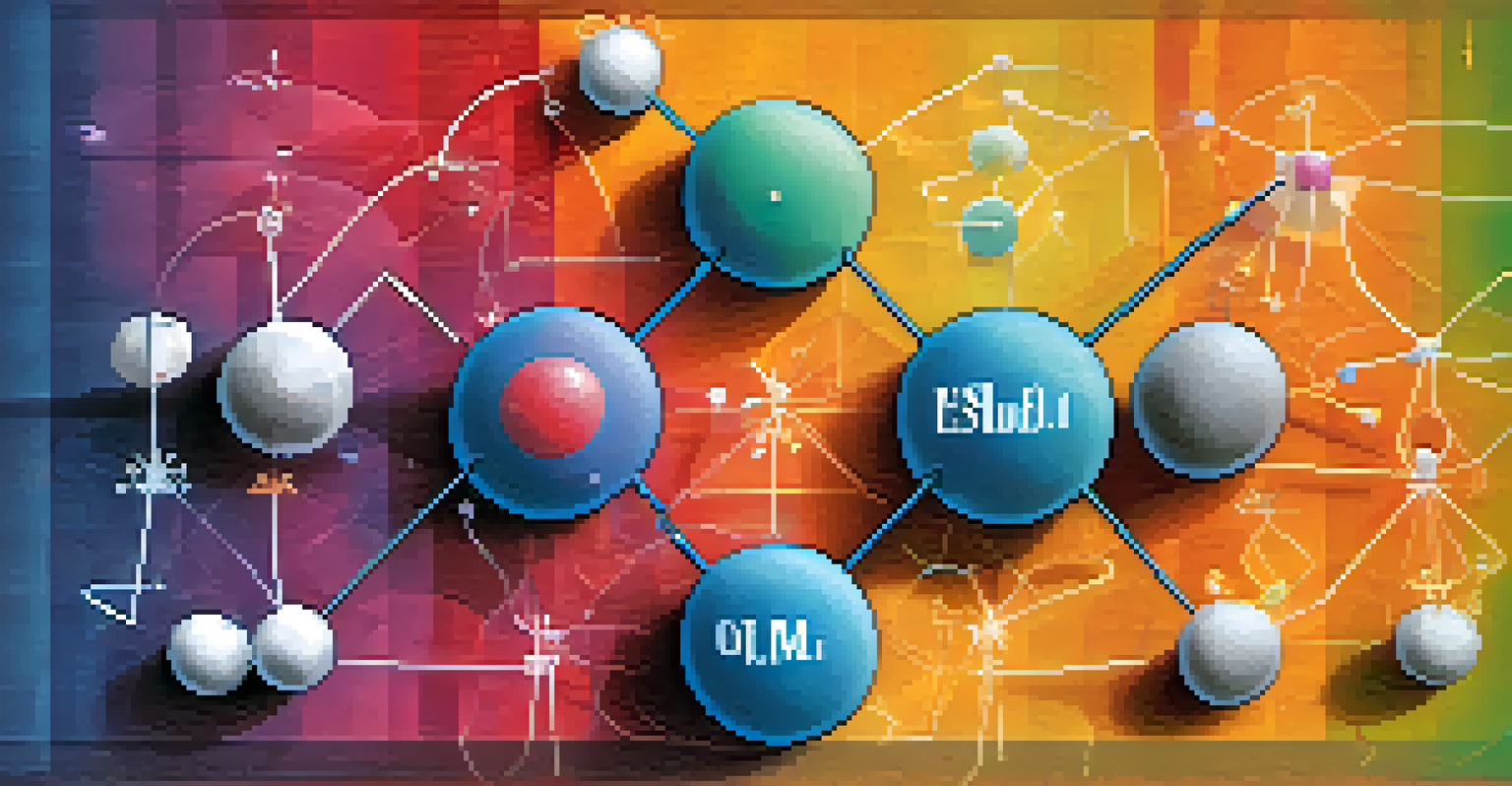Chemical Structures of Common Hallucinogens and Their Effects

Introduction to Hallucinogens and Their Significance
Hallucinogens are substances that alter perception, mood, and cognitive processes. They have been used in various cultures for spiritual and therapeutic purposes. Understanding their chemical structures can provide insight into how they interact with the brain and the body.
The greatest discovery of my generation is that a human being can alter his life by altering his attitude.
These compounds can lead to profound changes in consciousness, often described as mystical or enlightening experiences. However, they can also have adverse effects, making it crucial to study them carefully. By examining their structures, we can better understand their potential benefits and risks.
In this article, we will delve into the chemical structures of some common hallucinogens, exploring how these structures relate to their effects on users. This knowledge can help demystify these substances and promote informed discussions about their use.
Understanding LSD: A Powerful Hallucinogen
LSD, or lysergic acid diethylamide, is a potent hallucinogen known for its profound psychological effects. Its chemical structure is derived from ergot, a fungus that grows on rye. The intricate arrangement of atoms in LSD allows it to interact with serotonin receptors in the brain, leading to altered perceptions.

Users often report vivid visual hallucinations, heightened emotional experiences, and a distorted sense of time. While some individuals seek LSD for recreational use, it has also been studied for potential therapeutic effects, particularly in treating anxiety and depression.
Hallucinogens Alter Perception
Hallucinogens are substances that can profoundly change perception, mood, and cognitive processes, often leading to mystical experiences.
However, the unpredictability of its effects and the risk of psychological distress underscore the importance of understanding LSD's chemical makeup. This can aid in recognizing how it impacts the mind and body differently for each individual.
Psilocybin: The Magic of Mushrooms
Psilocybin is the active compound found in various species of mushrooms, often referred to as 'magic mushrooms.' Its chemical structure is similar to that of serotonin, allowing it to bind effectively to serotonin receptors. This interaction is primarily responsible for the hallucinogenic effects experienced by users.
Psychedelics can help us understand the nature of consciousness and the mind, but they also remind us of our fundamental connection to the universe.
When ingested, psilocybin is converted into psilocin, which is responsible for the psychedelic experience. Users may encounter visual distortions, enhanced creativity, and a sense of connection to nature and others. Research into psilocybin has shown promise in therapeutic settings, particularly for treating PTSD and depression.
Despite its potential benefits, psilocybin should be approached with caution. Understanding its chemical structure can help users appreciate the complexities of its effects and the necessity of responsible use.
DMT: The Spirit Molecule
DMT, or dimethyltryptamine, is often referred to as the 'spirit molecule' due to its powerful and intense psychedelic experiences. Structurally, DMT is similar to both serotonin and psilocybin, which helps explain its profound effects on perception and consciousness. It is naturally produced in small amounts by the human body but is most commonly consumed through plants.
Users often report experiences of entering alternate realities or encountering spiritual beings. The effects are typically short-lived, lasting about 15 to 30 minutes when smoked, which adds to its allure. However, the intensity of the experience can be overwhelming for some, making preparation and mindset crucial.
Chemical Structures Matter
Understanding the chemical structures of hallucinogens like LSD, psilocybin, and DMT helps explain their effects on the brain and body.
Research into DMT’s effects is still emerging, but its potential therapeutic applications, including treatment for addiction and depression, are gaining interest. Understanding its chemical structure is essential for grasping how it produces such unique experiences.
Mescaline: From Cacti to Consciousness
Mescaline is a psychedelic compound derived from the peyote cactus and other cacti like San Pedro. Its chemical structure is distinct, featuring a phenethylamine backbone, which is common among several hallucinogens. This unique structure allows mescaline to interact with the brain's serotonin receptors, producing its characteristic effects.
Users often describe mescaline experiences as deeply introspective, with vivid colors and patterns. The connection to nature is frequently emphasized, as many users report feeling a profound sense of unity with the environment. This has led to the use of mescaline in various spiritual and cultural ceremonies.
While mescaline is less common than substances like LSD and psilocybin, its effects and potential therapeutic benefits are worth exploring. Understanding its chemical makeup provides insight into its unique effects compared to other hallucinogens.
Ayahuasca: A Holistic Healing Brew
Ayahuasca is a traditional Amazonian brew made from the Banisteriopsis caapi vine and other plants containing DMT. The chemical structures of the ingredients work synergistically to create a powerful psychoactive experience. The vine contains MAO inhibitors, which allow DMT to be orally active, prolonging its effects.
Participants in Ayahuasca ceremonies often report profound spiritual insights, emotional healing, and even physical purging. The experience can be intense, often involving vivid hallucinations and deep introspection. Many seek Ayahuasca for its therapeutic potential, particularly in addressing trauma and mental health issues.
Weighing Risks and Benefits
While hallucinogens can offer therapeutic benefits, they also carry risks such as anxiety and psychological distress, emphasizing the need for informed use.
While Ayahuasca has gained popularity in Western cultures, it's essential to approach it with respect and understanding. Familiarizing oneself with its chemical components can enhance appreciation for its complexity and the cultural significance behind its use.
The Risks and Benefits of Hallucinogens
While hallucinogens offer unique experiences and potential therapeutic benefits, they also come with risks. Understanding their chemical structures can help users comprehend how these substances interact with the brain, which is vital for informed decision-making. For some, hallucinogens can trigger anxiety, paranoia, or lasting psychological distress.
On the other hand, studies suggest that hallucinogens may assist in treating various mental health issues, like depression, anxiety, and addiction. The growing body of research highlights the need for a balanced view, considering both the potential benefits and the inherent risks involved.

Informed discussions about hallucinogens should focus on education and awareness. By understanding the chemistry behind these substances, users can approach them with caution, maximizing safety while exploring their possible benefits.
Conclusion: Embracing Knowledge of Hallucinogens
Understanding the chemical structures of common hallucinogens can empower individuals to make informed choices. By exploring how these substances affect the brain and body, we can foster a more nuanced conversation about their use. As research continues to uncover the potential benefits and risks, knowledge becomes a key ally.
Whether for recreational or therapeutic purposes, educating ourselves about hallucinogens promotes responsible use. The more we know, the better equipped we are to navigate the complexities of these substances. Ultimately, embracing this knowledge can lead to safer practices and deeper understanding.
As we move forward, let’s continue to engage in open dialogues about hallucinogens, their chemical makeup, and their varied effects. This journey of exploration can pave the way for better awareness, acceptance, and potential healing.